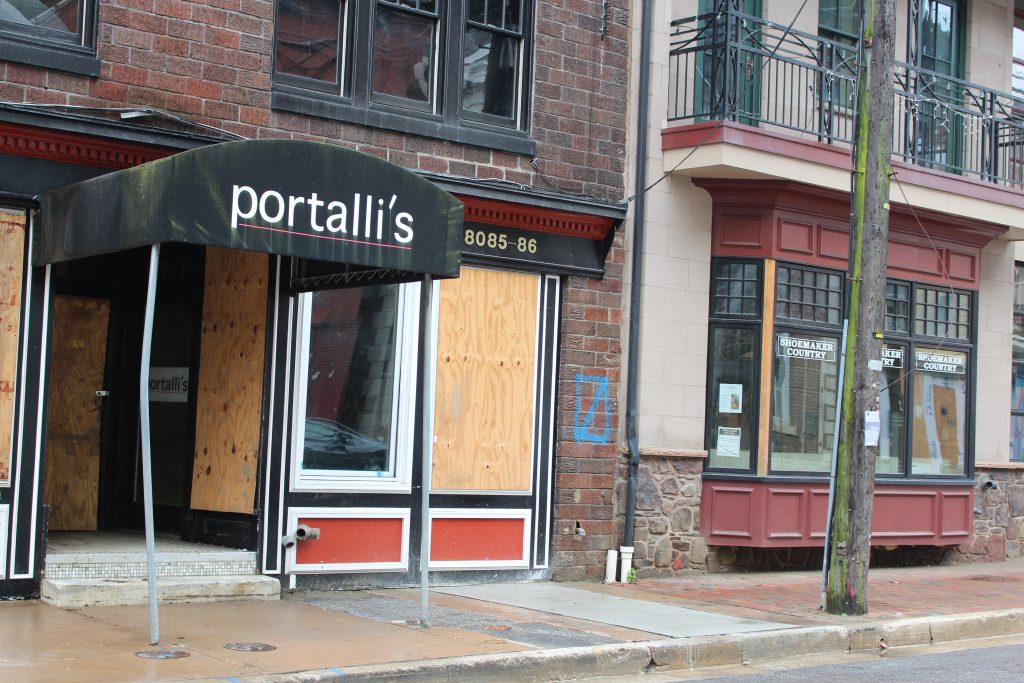
by Howard R. Fletcher
Capital News Service
ELLICOTT CITY, Maryland — Opinions are flowing in divergent directions over a five-year flood mitigation plan for Ellicott City, Maryland, that Howard County officials announced last week.
The county’s proposal includes razing a row of 10 tall, brick row buildings dating to the 1800s along the south side of Main Street, the path of the most damaging flood water. An estimated seven homes in the West End of the city could also be razed.
County officials see the plan as their best option to save lives and prevent further flood damage.
Some residents and historic preservationists are concerned that the plan goes too far and has been pushed through too quickly. Others say it’s long overdue.
Extensive rainfall on May 27, 2018, caused catastrophic flooding throughout Howard County; one person died in Ellicott City, where the downtown was quickly overtaken by flood waters.
Three people died there in a similar flash flood on July 30, 2016.
There are two primary elements to the county’s new mitigation strategy: first, to retain more water higher up in the watershed; and second, expand the floodplain throughout the town so that the destructive force of the water is lessened.
The county’s recommendation to remove the buildings is “a core component that would address the most immediate life safety threat on the town’s lower Main Street within one year,” according to the plan.
“We believe this plan is the best way save lives,” Howard County Assistant Chief Administrative Officer Phil Nichols told Capital News Service.
Nichols and Mark DeLuca, deputy director of Howard County’s Department of Public Works, presented the flood mitigation proposal to a Howard County Historic Preservation Commission meeting last week in Ellicott City.
Howard County’s chosen plan is called the Expanded Stream Channel Model.
https://www.howardcountymd.gov/LinkClick.aspx?fileticket=A3KL4ZSavCg%3d&portalid=0
The county’s plan presentation was preliminary, aimed at getting feedback, according to county officials.
“The master plan and any proposed removal of structures within the Historic District require the Historic Preservation Commission to review,” according to the proposal.
The commission must grant a Certificate of Approval before Howard County can proceed with the demolition, according to the proposal and statements made by officials during the hearing.
The county explored several plans to reroute the stormwater before setting on the proposal to raze buildings, DeLuca said.
The county’s recommendation to demolish buildings in the heart of Ellicott City’s historic district has evoked a mixture of reactions from county residents, historical preservationists and local business people.
“Saving lives and saving buildings should not be diametrically opposed,” Marjorie Valin of Columbia, Maryland, remarked during the public comment portion of the preservation commission meeting.
The new plan had been described by officials as a surgical approach, but it’s is more like an amputation, Valin told the historic commission.
“I urge you to thoroughly please discuss and analyze treatment options that don’t start by cutting the town off at its knees,” Valin said.
After the 2016 flood, Howard County hired a civil engineering firm, McCormick Taylor Inc., to “analyze projects suggested by the community, as well as by other engineers, so that all flood mitigation options would receive careful and deliberate review and consideration,” according to county documents.
Many people have criticized the fact that the county has been studying the flooding problem for years without action, but now there is a sense of urgency, DeLuca said.
“We could spend $80 million, and some areas could be slightly improved, others could be significantly improved … but in the studies (of alternatives) they always showed an 8-foot wall of water going down lower Main Street,” DeLuca told the commission.
The plan is estimated to cost $40 million to $50 million, and the county is seeking financial and technical assistance from the state and federal governments, according to the proposal.
It aims to divert Tiber Creek, which in the past two floods had become a river of floating cars, building materials and miscellaneous debris.
However, many historic preservationists feel that the county has not researched the problem thoroughly enough.
“In your bylaws and in preservation, you know that demolition is the option of last resort after you have exhausted everything, and we are far, far, far from exhausting every option,” said Shelley Davies Wygant, a 21-year resident of Ellicott City who has authored two books about the town.
Wygant started a Facebook group called “Let’s work to save Historic Ellicott City.” The group has over 1,300 members.
On Facebook, the group exchanges and explores other options on how to reduce flooding, while still preserving the historic character of the city, Wygant said.
Elly Colmers Cowan, director of advocacy of Preservation Maryland, a historical preservation non-profit based in Baltimore, also expressed reservations.
“More work is needed to understand the impact of demolition of these historic structures,” said Cowan. “The economic, historic and hydrologic impact must be fully understood before an irreversible process begins.”
Preservation Maryland is willing to pledge funds to the study and potential planning necessary to explore alternatives to the county’s plan, Cowan testified.
James A. Massey of Woodbine, Maryland, a self-proclaimed “lifelong resident of Howard County,” who was “born and raised in a house overlooking Main Street,” said the newest proposal is long overdue.
“I support the county’s plan in the essense of public safety,” Massey testified. “The time for studies is over. We’ve lost too many lives.”
The majority of people who spoke at the historic preservation hearing were in agreement that the city needs a solution.
But some residents remain ambivalent about the proposed demolition.
“It’s just weird to think that they are just going to knock down a section of buildings that have been a part of Main Street for so long,” Brian Douglas, a bartender at Ellicott Mills Brewery for over 10 years, told Capital News Service. “I feel bad for businesses like Phoenix (Emporium) … who have been here for over 40 years.”
Phoenix Emporium and Shoemaker Country are just a few of the several established businesses that would be displaced by the removal of the 10 proposed Main Street buildings.
“It’s just a shame,” said Douglas.
The plan also states that the county is planning to acquire and remove an estimated seven residential properties in the town’s West End between Ellicott Mills Drive and Rogers Avenue to mitigate flooding there. The details of the West End plan have not yet been released.
Howard County Executive Allan H. Kittleman and Councilman Jon Weinstein officially announced the plan during a presentation to the County Council at a legislative session on Aug. 23.
“These storms are going to be more frequent, harder to predict and potentially more deadly,” Kittleman said last month. “With all of this in mind, we can’t wait any longer to act.”
The next Historic Preservation Commission meeting is scheduled for Oct. 4, when county officials are expected to present the flood mitigation plan again for advisory comments, according to the Howard County Department of Public Works.
Get PERKS and Support Community Journalism | SUBSCRIBE
